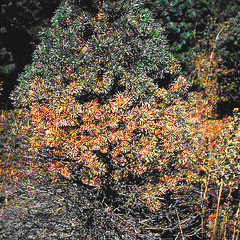The Ortho Home Gardener's Problem Solver
Pinus: Needle Cast
 Problem
Problem
The tips of the needles on last year's growth turn brown in winter. By spring, the infected needles are completely discolored, giving the tree a scorched appearance. Many needles may drop from the tree, leaving only the new green growth. Tiny, black, elongated structures develop on the midrib of dead needles. The black structures may be swollen, with cracks down the middle. In severe cases, branch tips die back. Shaded parts of the tree are more frequently infected.
Analysis
This plant disease is caused by either of 2 species of fungi (Hypoderma lethale and Lophodermium pinastri). It is most severe on young pine trees, but older trees may be infected on the lower branches. In the summer, during wet weather, spores are released from the elongated black fruiting structures on infected needles. Splashing rain and wind may carry the spores several hundred feet. The fungus enters the tissue but the symptoms do not appear until early the following spring. Brown spots with yellow margins develop on the needles in March or April. The fungus grows through the tissue, and by late April or May the needles are completely brown. The needles drop, and the spores from these infections continue the cycle.
Solution
If needle cast was serious in the spring, spray valuable specimens with a fungicide containing chlorothalonil starting in late July. Repeat the spray at intervals of 10 to 14 days through September. If trees are shaded, remove any shade-producing structures or plants, where practical.
Copyright©1997. Books That Work.
Copyright©1982, 1993, 1997. Monsanto Company.
Visit Books That Work at http://www.btw.com
